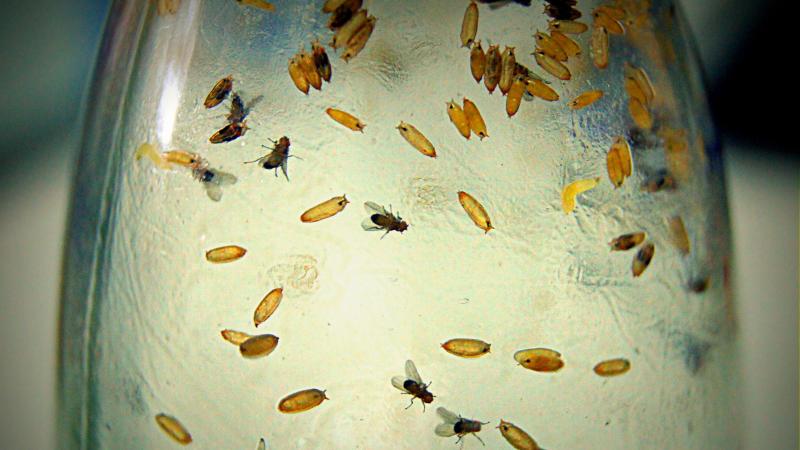
Think of fruit flies, and a picture of tiny, brown insects sitting on a rotten banana comes to mind. Think a little further. Have you ever seen these flies hovering around anything that tastes bitter? Perhaps, not! A fruit fly, or Drosophila, decides to eat or not eat something just like we do—by tasting it. Once it lands on potential food material, information is passed from the receptors on its body surface to its brain, helping it decide whether the stuff is good to eat. If it is found suitable, the fly extends its proboscis, the tube-like organ it uses in feeding, and drinks up the food juices.
So, how does the Drosophila distinguish between tastes and identify edible food? This question got researchers from the National Centre for Biological Sciences (NCBS) thinking, which resulted in a study identifying the neurons involved in making the flies avoid bitter substances. “We always wondered if a fly uses different neurons for processing different types of taste, or if there was a common neural circuit for all”, shares Mr. Ali Asgar Bohra, a research scholar at NCBS and an author of the study.
Although surprising, it is true that the Drosophila has a taste profile very similar to ours; it can detect chemicals in food like carbohydrates, acids, and salt. Hence, scientists use it as a ‘model organism’ for studies on taste reception and processing. In insects, the gustatory information is processed in a part of their brain called the ‘suboesophageal zone’, located below the oesophagus. This region has neurons which control eating and extension of the proboscis. We know how the Drosophila brain processes sweet taste, but not much is known about how it handles other tastes.
Fruit flies extend their proboscis when water or a sweet substance such as sugar stimulates the tips of their legs. However, when presented with unwanted or offensive material, such as quinine, they do not extend their proboscis. The researchers of this study hypothesised that neural circuits in the suboesophageal zone help to transfer information from taste receptor neurons to motor neurons that control the proboscis. Experiments showed that when flies were presented with a bitter substance, one or more of a group of neurons, labelled by a transgenic line of flies called VGN6341, were activated. This inhibited the proboscis from extending. Deactivating these neurons enabled the proboscis to extend even to aversive substances.
The researchers found that a majority of the VGN6341 neurons were located in the suboesophageal zone. They belonged to a class of neurons which connect groups of neurons in one region of the brain with those in the other areas. Such neurons, called ‘interneurons’, communicate between sensory and motor neurons. Further, they found that the bitter taste receptor neurons indeed lay close to the VGN6341 interneurons, making signalling between the two likely. They saw that there was no signalling between these interneurons and receptors of other tastes (such as sweet and water)—an observation that implied that the interneurons were specific to bitter taste and that the flies possessed a separate neural circuit for bitter taste processing.
“The connection between bitter sensory neurons and interneurons labelled by VGN6341 was surprising and a little unexpected. The most difficult part of the study was to identify one interneuron that is involved in bitter taste processing. Since the VGN6341 labels many neurons in the brain, we were trying really hard to identify the one interneuron that gave us that behavioural phenotype”, remarks Mr. Bohra.
To obtain indisputable proof that functional connections exist between the extension of proboscis and the neurons of interest, the scientists employed a technique known as CaMPARI, which allows imaging of cellular activity in real time. In this technique, a fluorescent sensor changes from green to red upon neural activity, thus helping to trace the neurons involved in that particular behaviour. When the flies tasted a bitter mixture of caffeine and quinine, the researchers observed intense red colour in only one cell in each half of the suboesophageal zone. This observation confirmed that just a single, bilaterally homologous pair of interneurons was involved.
This study is the first to report that a local interneuron in the suboesophageal zone of Drosophila is involved in processing bitter taste. Understanding the neural circuit of the processing of taste modalities will help in discerning how flies and other insects perceive their environment. It could also prove helpful in understanding how insects such as mosquitoes sense chemicals and could help create better repellents and pesticides.
“The gustatory systems of insects and mammals have similar anatomical features and use similar molecular mechanisms for taste coding. This study is significant for understanding how gustatory stimuli are perceived and responded to by the brain in mammals, including humans”, signs off Mr. Bohra, explaining the implications of the study.






